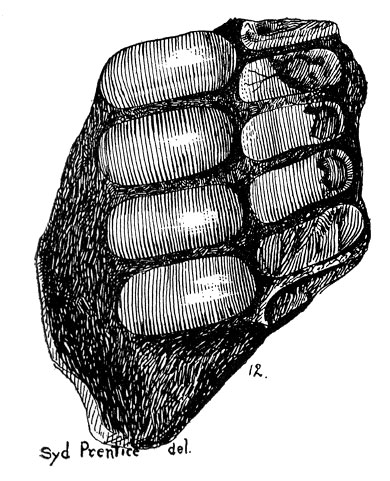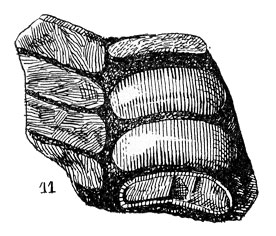Prev Page--Lamnidae || Next Page--Lepidosteidae
Pycnodontidae
The pycnodonts are a peculiar group of ganoid fishes, whose remains have been found in the Jurassic, Cretaceous, and Eocene deposits of Europe, North America, Asia, and Australia. They are all rather small fishes, very much flattened and oval in shape, covered with rhomboidal scutes having close-lying spines, which give a ribbed appearance. The united palatine and vomer of the upper jaws are provided with five rows of round or oval, smooth-pavement teeth; the premaxillary with two or four chisel-like teeth. The dentaries below have a like number of teeth, similar to those of the premaxillary, while on the splenial there are three, four, or five rows of pavement teeth similar to those of the vomer.
Coelodus brownii. Plate XXIV, fig. 12.
Coelodus brownii Cope, Journ. Acad. Nat. Sci. Phil., IX, p. 447, pl. XX, f. 19; Williston, cf. cit. 28.
Plate XXIV, Fig. 12--Coelodus brownii Cope, imperfect left splenial dentition, natural size.

A fragment of the left lower jaw, containing two rows of teeth, the middle and the inner. There are four crowns preserved on the inner row, nearly corresponding in length with the six teeth of the middle row, of which only two have the crowns preserved. Cope's type had only the middle and external rows, and none of the teeth had well-preserved crowns. The middle teeth seem to correspond exactly in size with the types.
On the inner side the jaw projects as a rather broad trough, with a thin edge, apparently broader posteriorly than anteriorly. Its width here is nearly as great as the width of the inner row of teeth. The inner teeth are large, their width equal to nearly half their length. The surface of the crowns is smooth and convex, more so antero-posteriorly than transversely. The middle row has the teeth placed a little obliquely to the others, and the surface is more flattened transversely in the middle. The axes of the crowns of the two rows are placed at a distinct angle with each other.
| Length of four teeth, inner row | 36 mm |
| Transverse diameter of crowns, inner row | 17 mm |
| Length of five teeth, middle row | 31 mm |
| Transverse diameter of crowns, middle row | 12 mm |
| Thickness of jaw, at middle row of teeth | 22 mm |
The specimen was collected from the Kiowa shales, near Belvidere, by Mr. C. N. Gould.
Coelodus stantoni, n. sp. Plate XXIV, fig. 12 [sic. 11]; plate XXVI, fig. 6.
Coelodus stantoni Williston, cf. cit. 28.
Plate XXIV, Fig. 11--Coelodus stantoni Willist., imperfect right splenial dentition, natural size.

A fragment of the right lower jaw, containing two perfect crowns of the internal row, together with the bases of four teeth of the middle row, evidently represents a species distinct from the previous one. The teeth are much smaller in size, more elongated and distinctly kidney-shaped, the ends narrowed. The surface is smooth, strongly convex antero-posteriorly, and gently so from side to side. The jaw is much less robust than in the preceding species.
| Transverse diameter of tooth, internal row | 14 mm |
| Antero-posterior diameter of same | 53 mm |
| Length of four teeth, middle row | 17 mm |
| Transverse diameter of tooth, middle row | 11 mm |
The middle teeth seem to be larger in proportion to those of the internal series than in the preceding species. Kiowa shales.
Mesodon abrasus.
Mesodon abrasus Cragin, Colorado College Studies, V, 1894; Williston, Kans. Univ. Quart., IX, p. 29.
"This name is proposed for certain pycnodont teeth of low, rhomboidal form and feebly convex upper surface which occur in No. 3 of the Belvidere section, southwest of the Belvidere railroad station, and seem to agree with the large mandibular teeth of Mesodon. The specific name refers to the occurrence in the type species of two small, oblique facets produced at one end by attrition. The type has a height (above root) of 3 mm, a length of 13 mm, and a breadth of 5 mm.
"To the vomerine set of the same species may belong the rotund, oval or nearly hemispherical teeth of similar height but smaller size, which occur not uncommonly at the same locality and horizon, the largest now available example of which measures about 6 and 7 mm in major and minor horizontal diameters."
In the National Museum collection there are several teeth, occurring singly, corresponding to the vomerine teeth described by Cragin. That they belong with the other teeth there described is very doubtful - indeed it is doubtful whether the other teeth belong with Mesodon, since it is impossible to locate the genus from single teeth. It is not at all impossible that the vomerine teeth are identical with Cope's M. diastematicus. The larger teeth may be the same as those of either the above-described species of Coelodus.
The largest of the specimens in the present collection measures 10 by 7 1/2 mm; several smaller examples have diameters of 6 and 5 mm. (See plate XXX, fig. 4.)
Prev Page--Lamnidae || Next Page--Lepidosteidae
Kansas Geological Survey, Volume V1, Cretaceous Fishes
Comments to webadmin@kgs.ku.edu
Web version July 2004. Original publication date 1900.
URL=http://www.kgs.ku.edu/Publications/Bulletins/Vol6/04_pycno.html